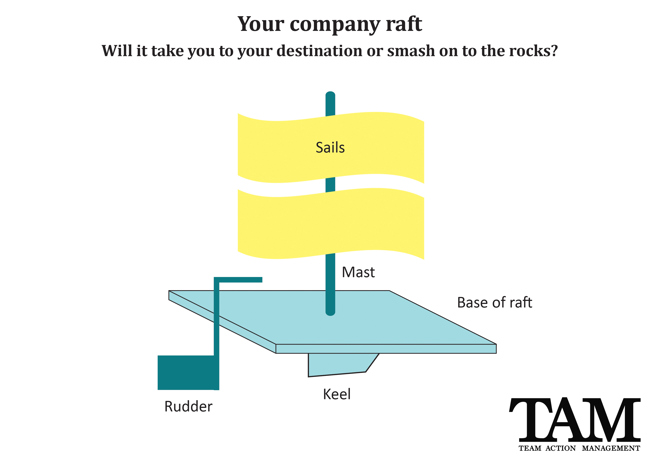Will your company raft take you to your destination or smash on to the rocks?
Press release June 12, 2009 BusinessPhilip Webb, CEO of TAM (UK), demonstrates how planning and sound management can prevent businesses from hitting the rocks

With management failure – not lack of sales – causing the collapse of 9 out of 10 businesses that go bust – many with full order books – how do directors or owners ensure they manage staff, sales, cashflow, debt and other key factors effectively?
Philip Webb, CEO of TAM (UK) plc, suggests that, to ensure their business is among the 17% to survive beyond five years, directors should ask themselves four questions every month:
- How much cash is available to run your business?
- What is the level of sales this month and what is realistically projected for next month and the month after?
- Are all the directors actually controlling your business or are they doing the work of the business? Do you hold a monthly board meeting?
- Are directors doing everything to leverage opportunities to increase sales, cash and efficiency?
By focusing on the answers to these questions, you can liken your business to a raft. A raft is intrinsically unstable and needs constant management, just like a company.
The raft base represents the structure of the company . . .
. . . including premises, equipment, stationery and paperwork, forms and processes. The people who travel on the raft are you and your employees. How the company operates and how it is managed determines whether it rides the tides and storms to reach its destination or sinks in the deep.
The keel represents cash . . .
. . . in the bank or available to your business. The more cash, the deeper the keel and the greater the stability of the raft. Stepping on to a raft with no keel can send everything into the water – it’s the same with a company with no cash.
So sufficient cash – working capital – is necessary to keep your business afloat.
The rudder represents the directors . . .
. . . who steer the company. The size of the rudder is directly related to the skills and abilities of individual directors, especially the managing director, and the frequency and effectiveness of board meetings. As a rudder, the board provides direction.
The mast represents the customer database . . .
. . . and a clearly defined list of customers, which, regularly managed, updated and cleansed, helps to maintain sales. The bigger the database and the better it is managed, the higher the mast and the greater potential for sales.
The sails represent sales . . .
. . . with greater areas of canvas generating more revenue. Sales methods, eg direct sales or agents, are represented here and the direction of sales and their shape reflect different types of market. A small, square sale can propel the raft as fast or faster than a large, shapeless sale that is not aligned to the wind.
Trimming the sails can be considered as analysing your marketplace, looking for marketplace advantages, targeting niche markets and obtaining maximum returns from your salesforce.
Catch the wind and set sail
To set sail, a business plan adjusts the rudder and an operational office is set up as the base of the raft. Borrowing money to match your own establishes the keel, while marketing mailshots or sales calls hoist the sails. The result is a workforce to drive sales, manage manufacturing, finance and other operations, creating a full order book and a growing customer base. As the sails are adjusted, the raft picks up speed.
Struggling to keep on course
What happens next is up to you! Chances of survival drop dramatically at this stage unless you manage the raft effectively, as over 83% of businesses survive less than five years. A full order book doesn’t guarantee success either, as 9 out of 10 businesses go bust due to management failure, not lack of orders.
Usually management failure lies, not in people or sales management, but in the management of finance and in strategic direction setting, both inextricably linked.
Casfhflow, represented by the keel, can shrink fast due to unmonitored payments from customers and poor debt collection. Even where a business is travelling at speed with high sales, the lack of cash reduces the size of the keel and causes dangerous instability. Banks sound warnings and refuse to extend credit, and borrowers look for repayment of their loans. Where the directors take note at this stage, the rudder is ineffective due to their lack of skill and failure to hold formal meetings.
Finally, the business capsizes, throwing everybody off into the deep and crashing the company.
Staying afloat and succeeding
Not every company will crash, as poor cashflow can sometimes be managed with a large enough rudder – even a coracle is stable in the hands of a skilled oarsman.
However, it’s still better to ensure the rudder is big enough to direct the company. There’s only one way to achieve this and it’s very simple: ensure directors maintain essential management skills and hold regular formal board meetings.
With informed, strategic direction from the directors, the company raft should remain stable however fast it is propelled by growing sales.
• For full details ofTeam Action Management™ and how its proven methodology equips directors to plan and manage effectively, please call Philip Webb, chief executive of TAM (UK) plc, on 07711 008350 or any of the dedicated TAM team on 0114 299 8885, or visitwww.tamplc.com
Subjects
Business


 Follow
Follow